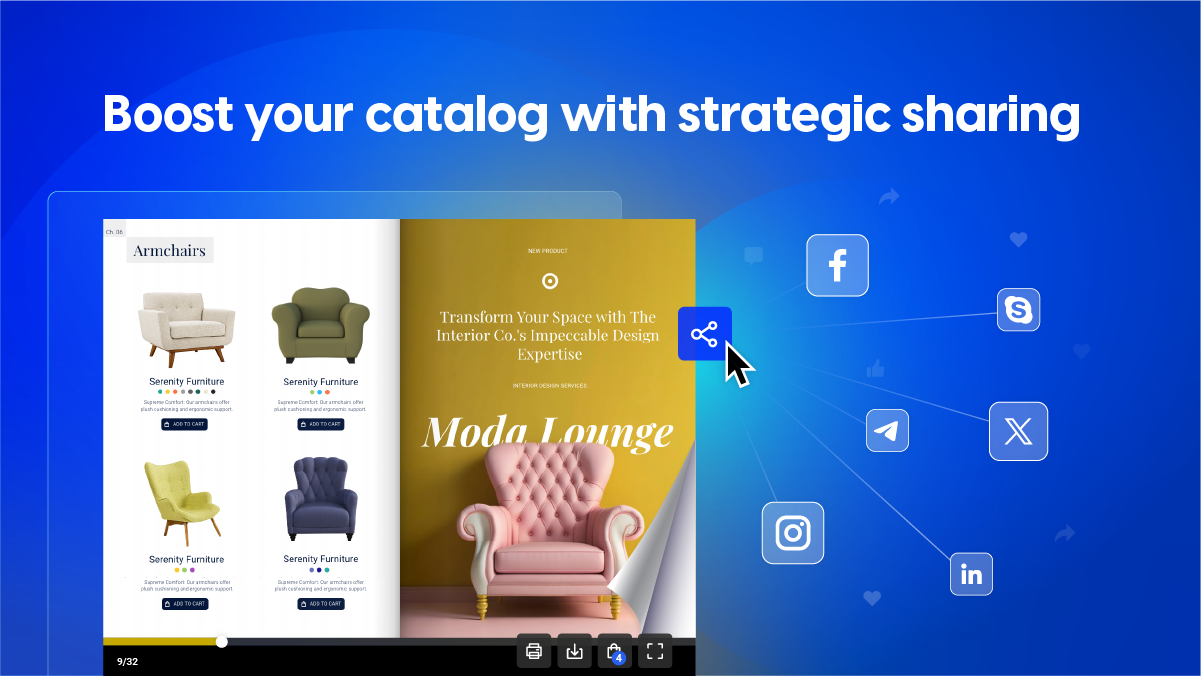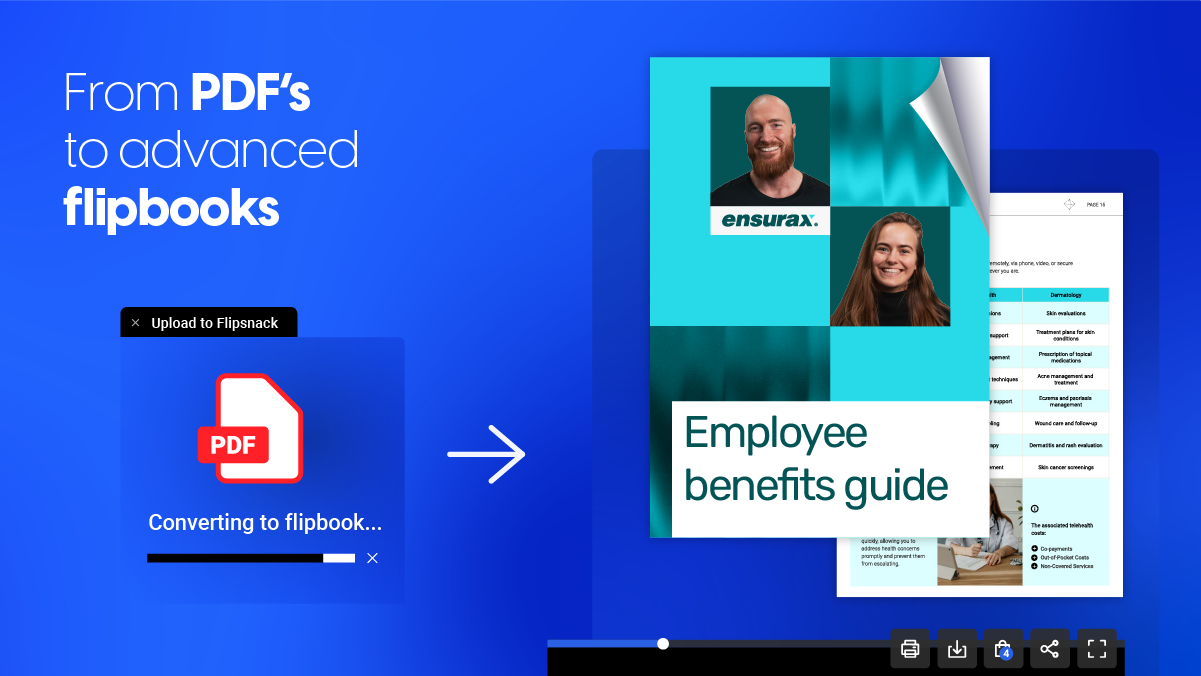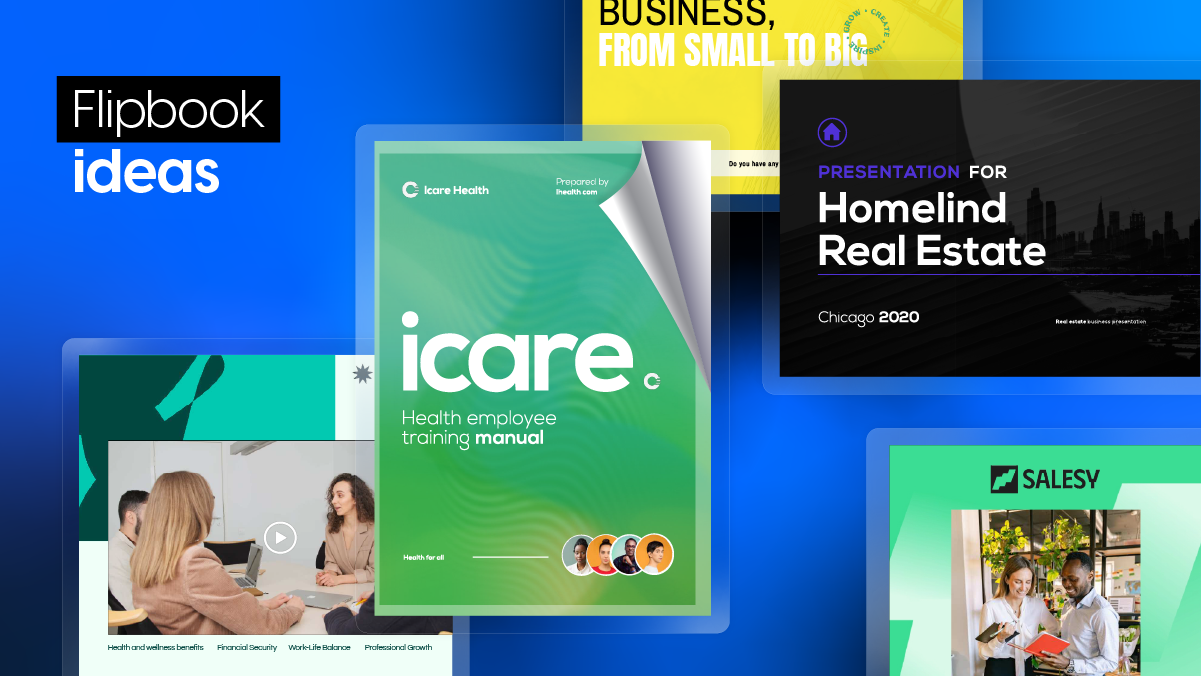Boost your catalog’s impact with strategic online sharing
In the complex world of commerce, effective marketing strategies are essential for driving business growth and achieving success. For wholesale, retail, and manufacturing companies, winning marketing strategies can take various forms, whether they aim to expand audience reach or drive higher conversions. Achieving these goals often involves a blend of offline and online tactics.
Traditional offline marketing methods, such as printed catalogs, face significant limitations in terms of audience reach. The broader the target audience, the higher the costs associated with production and distribution. In contrast, digital catalogs offer a cost-effective solution that can be shared online across various platforms without straining the company budget. Once transformed into an interactive flipbook format, digital catalogs become more engaging and accessible, significantly increasing the likelihood of reaching and captivating target audiences. These digital catalogs provide a convenient, one-stop shopping experience that can be enjoyed at home and at the user’s own pace.

Let’s explore how online catalog distribution can enhance audience reach and how to incorporate it into your marketing strategy effectively.
Importance of digital catalog distribution
Ever since digital catalogs became an alternative use of marketing budgets, their profitability drove the transition as more companies and industries understood their benefits. While the decrease in the cost of production and distribution becomes virtually non-existent, you don’t have to consider every new platform on which you want to promote your products and services. If one link can engage audiences regardless of where they are and reach sales teams across the countries in seconds, the choice for online catalogs couldn’t be clearer.
Why should companies harness the power of digital distribution channels?

Digital catalog distribution offers numerous benefits that make digital catalogs a valuable tool in the marketing arsenal of companies across various industries. While there are many reasons why companies transition from print to digital catalogs, the distribution versatility takes the cake. Here are some key reasons why companies should adopt digital catalog distribution:
1. Enhanced reach: Unlike printed catalogs, digital catalogs can be distributed globally without incurring high costs, as we already stated. With digital catalogs, distribution is done online through various communication channels, and most of these channels don’t require costs to access their large audiences. This allows businesses to reach a wider audience, including international markets, without the logistical challenges and expenses of printing and shipping physical copies. We’ll get into more about the versatility of digital distribution channels shortly.
2. Cost savings: Print catalog production and distribution can be expensive, particularly when targeting a large audience. Distributing them across a wide geographical area can also be costly. Digital catalogs eliminate these costs, providing a more budget-friendly option that still delivers high-quality content to potential customers. The extra benefit is that these digital catalogs are also more interactive than their physical counterparts.
3. Improved engagement: Digital catalogs can include interactive elements such as videos, clickable links, popup frames, and animations, making them more engaging than static printed versions. This interactivity can capture the attention of potential customers and keep them engaged longer, increasing the likelihood of conversions. Then, there’s the option to transform an already interactive catalog into a shoppable catalog from which your customers can place orders, make wish lists, and complete purchases without having to connect to a third-party system.
4. Real-time updates: Unlike printed materials, digital catalogs can be updated in real time to reflect changes in inventory, pricing, or promotions. Whether the content is converted from a PDF file with spelling errors or the information within a catalog created from scratch changed over time, content and product information can be updated or fixed even if the catalog was already shared with the audience. The link they have will simply take them to the updated version, removing the need to send them the latest information in a new catalog. This ensures that customers always have access to the most current information, enhancing their shopping experience.
Understanding the audience and objectives
Before you think about how you are going to reach your target audience, you first need to establish who is included in the mass of potential customers you want to reach and why you want to reach them. While establishing your ideal client persona and objectives is necessary when you design your marketing campaign, it’s relevant in digital catalog distribution due to the differences in behavior between demographics.
Importance of understanding your audience’s behavior
To effectively reach your audience, it’s crucial to understand their behaviors, preferences, and needs. Businesses can gather valuable insights into what their audience is looking for by conducting market research, surveys, and analyzing customer data, but they can also establish where their audiences spend their time, therefore understanding how to reach them best. Tailoring your digital catalog distribution methods to match their behavior can increase engagement and conversions. For instance, a 53-year-old marketing analyst may be used to email distribution, while a 25-year-old student is more susceptible to social media content shared by influencers. Understanding your audience means knowing where and how to reach them.
Set clear goals for your digital catalog distribution
Clearly defined objectives will guide your sharing strategies. Whether your goals include increasing sales, boosting brand visibility, or introducing new products, understanding the purpose of your catalog is essential to knowing what catalog distribution avenues to take. For example:
Increasing sales: Focus on showcasing bestsellers through carousels that highlight benefits and usability and motivates customers to make a purchase. Offer promotions and include strong CTAs that are visible in the images used, while descriptions can be used to enforce the product’s relevance for your audience.
Boosting brand visibility: Highlight brand stories, values, and unique selling points that can bridge the gap between your organization’s values and your audience. Once a connection is made and your customers know to associate your brand with values they might share themselves, you’ll become a brand they’ll trust and want to associate with.
Introducing new products: Use eye-catching visuals and detailed descriptions to draw attention to new items. If it’s a product that can be included in a category or family of products, showcase it in focus among the others. If it’s a stand-alone product, you can focus on its benefits and how it can improve your customers’ lives.
Each goal will influence how you design and distribute your electronic catalog, ensuring that your efforts are aligned with your desired outcomes. Creating a marketing strategy without a goal or an audience in mind can significantly increase your marketing costs and hurt your brand in the long run. So, fragment your audience, establish your goals, and determine the best distribution channels for your marketing efforts. Let’s see how these effective online sharing strategies can be implemented for your business’s success.
Effective online sharing strategies
Implementing effective online sharing strategies is crucial to maximizing the reach and engagement of your digital catalogs. Leveraging various social media platforms, email marketing, embedded links, and QR codes can significantly enhance the visibility and accessibility of your catalogs because, with distribution versatility, you’ll be able to reach customers wherever they may be. Below, we explore best practices for each method to help you distribute your digital catalogs more efficiently and as effectively as the digital world allows.
Social media platforms
Online distribution options take many forms when it comes to social media platforms. Knowing how to leverage each method can influence the effectiveness of your marketing distribution campaign. Here, we’ll explain how each platform can be used, with what tools, and for which audience. While sharing a link online is simple, for effective marketing efforts, you can take an extra step and ensure you reach your audience. Whether it’s sharing a preview of your digital catalog or designing a carousel featured on promotions, make the best of what these platforms offer as a way to stand out amongst competitors and engage your audience.
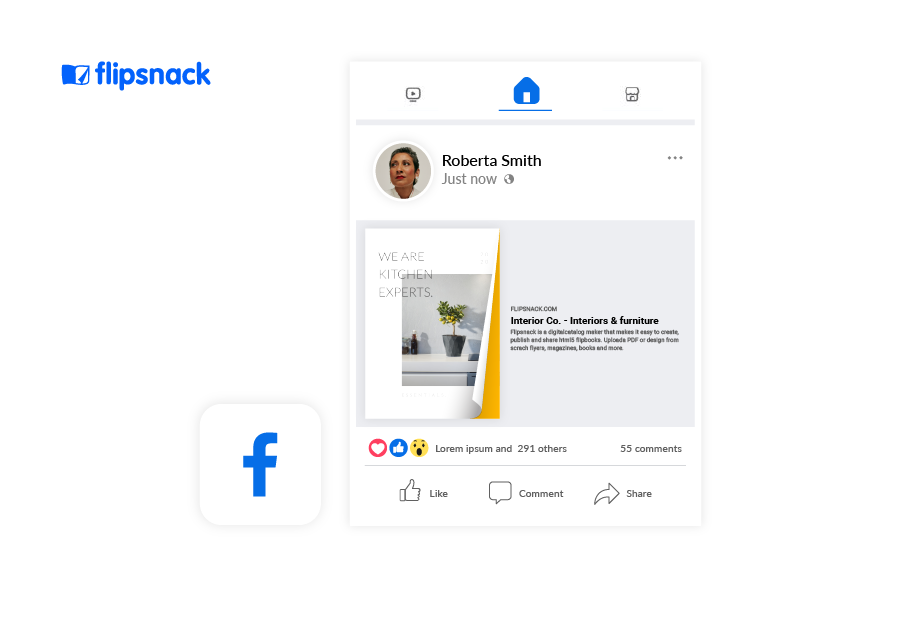
With around 2.9 billion global monthly active users, Facebook can help you reach virtually any age demographic, the most prominent being between 18 and 44. While people spend time on Facebook to stay in touch with friends and family from across the globe, the platform has become a global incubator, outreach tool, and lead generator for countless businesses through Facebook Ads. With tools that boost engagement, promote web traffic, and allow you to narrow down your target audience, you can create a strategy that limits your efforts while maximizing your reach.
Features: Carousel ads, product catalogs, shop sections
Best Practices: Utilize visually appealing images, engage with followers through comments and messages, and use Facebook Ads Manager for targeted campaigns. Facebook’s robust ad platform allows for precise targeting based on demographics, interests, and behaviors, ensuring your catalog reaches the most relevant audience.
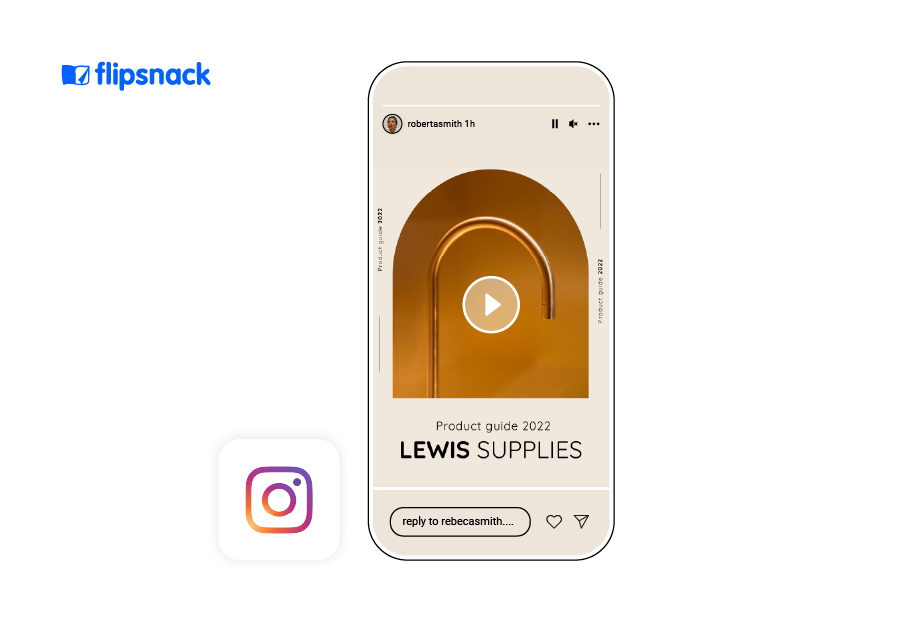
For the best results on Instagram, you’ll have to convert your company’s profile to a business one and craft a compelling bio where you can share the brand story. Include a call to action and link other relevant online platforms (website, digital catalog, connected or unconnected social media platforms) with an eye-catching profile picture. But design doesn’t stop at the profile picture. Any product or service promoted through Instagram requires high-quality images of products or designs that showcase services the best. Publish content consistently to grow your following and maintain relevance in the field while tracking the results for future strategy adjustments when necessary.
Features: Shoppable posts, stories, IGTV
Best Practices: Focus on high-quality visuals, use relevant hashtags, and collaborate with influencers to broaden reach. Instagram’s visual-centric platform is perfect for showcasing products in a visually appealing manner. Utilize Instagram Stories and IGTV for behind-the-scenes content and product demonstrations.
X (former Twitter)

Engaging more than 217 million users daily makes X an essential media platform for boosting engagements, growing business, and building a community around your brand. Its fast-paced rhythm may require a content catalog and scheduled tweets for optimal post times for a foolproof marketing strategy, but while that can help ensure you have consistency in posts and social engagement, it also gives wiggle room for unplanned content that may arise with new products or product reviews you may want to promote. Visuals, like on any other platform, are highly engaging, with videos generating the best number of likes, retweets, clicks, and page visits. Share catalog previews that spark audience curiosity and invite them to browse through your catalog or create individual product posts to showcase promotions, discounts, or new products.
Features: Twitter Cards, Twitter Trends, Twitter Community, promoted tweetsBest Practices: Use concise and engaging messaging, leverage trending hashtags or create branded hashtags, and interact with followers in real-time. Twitter’s fast-paced environment is ideal for sharing quick updates and promotions. Use Twitter Cards to enhance the visibility of your catalog links to generate up to 43% more engagement.
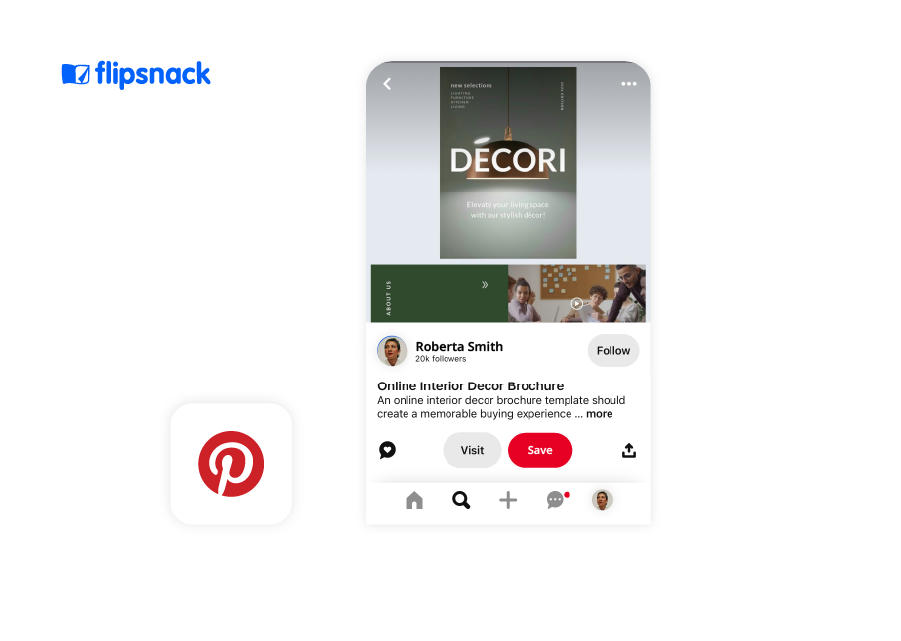
Engaging more than 518 million monthly active users and popularity that bridges any generational gaps, Pinterest is a powerful platform for boosting engagement, growing your business, and inspiring your audience through visually-driven content. As Pinterest is known for its ability to showcase products through high-quality visuals, it allows brands to create and maintain organized and visually appealing catalogs of pins, enhancing the platform presence of any company. Platform users discover and save content, whether that content is a catalog preview or a product’s individual promotional post. Pins can be optimized with relevant keywords and descriptions for maximum audience reach, and rich pins provide additional context for the products you’re promoting.
Features: Rich pins, catalog integration
Best Practices: Optimize pins with keywords, ensure visual quality, and create boards for product categories. Pinterest’s audience often seeks inspiration and ideas, making it a great platform for lifestyle and product-based catalogs.
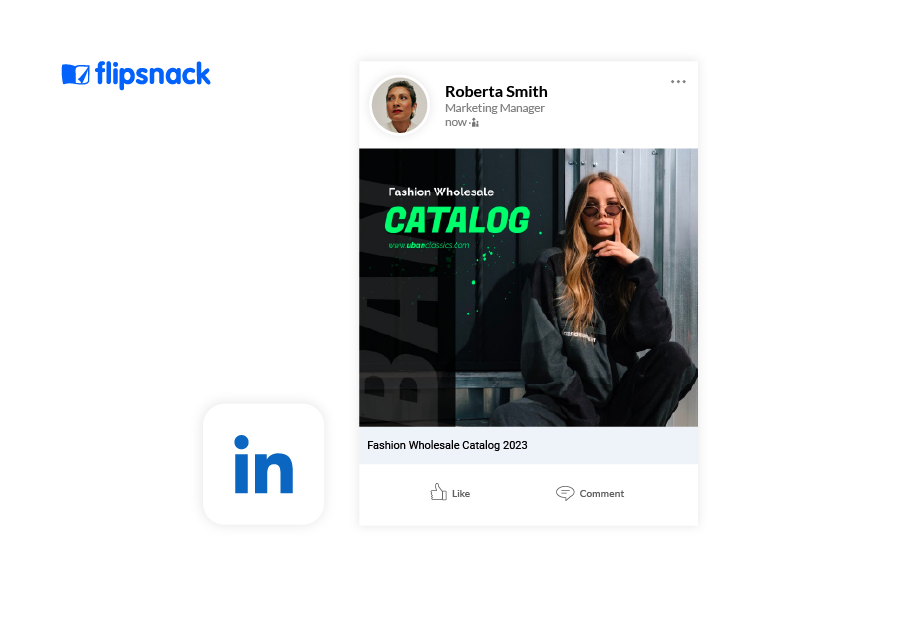
Like other social media platforms, LinkedIn can be leveraged for engagements and business growth, but where it stands separate from others is in regards to building industry connections. While its user base may seem less expansive than other social media platforms, its 134.5 million daily active users are predominantly from professional or corporate backgrounds. Known as an engagement platform aimed at corporate individuals, the tone used needs to be professional with industry-relevant content that engages audiences with similar interests. Detailed posts about products or product listings include the type of content these audiences prefer, and a professional and informative catalog preview fits right in. Posts can be optimized with relevant keywords, and by using Showcase pages and product features for more detailed information, you can enhance audience engagement further.
Features: Showcase pages, product listings
Best Practices: Maintain a professional tone, share industry-relevant content, and engage with B2B audiences. LinkedIn is particularly effective for reaching a professional audience, making it ideal for B2B catalog distribution.
YouTube
YouTube is the most powerful platform, and we can say this only by looking at its user base. With 4.95 billion monthly active users and going stronger, engagement boosting and reach of a wide audience is achieved through engaging video content. Known for its in-depth product demonstrations and storytelling capabilities, YouTube excels in showcasing products via high-quality videos and detailed descriptions, as well as how-to-use or unboxing videos, providing users with all the information they could possibly need about products or services. By creating and maintaining an engaging and informative channel, you can significantly enhance your brand’s visibility on the platform. YouTube’s format encourages content discovery and viewer interaction, making it ideal for catalog previews and individual product showcases. Optimizing your videos with relevant keywords, strong CTAs, and compelling content increases visibility and attracts a broader audience. Additionally, utilizing YouTube Analytics to track performance and refine your strategy further enhances engagement by ensuring your content resonates with viewers.
Features: Video demonstrations, product links in descriptions
Best Practices: Create engaging and informative content, include strong CTAs, and use YouTube Analytics to track performance. YouTube allows for in-depth product demonstrations and storytelling, providing a rich media experience for your audience.
Email marketing
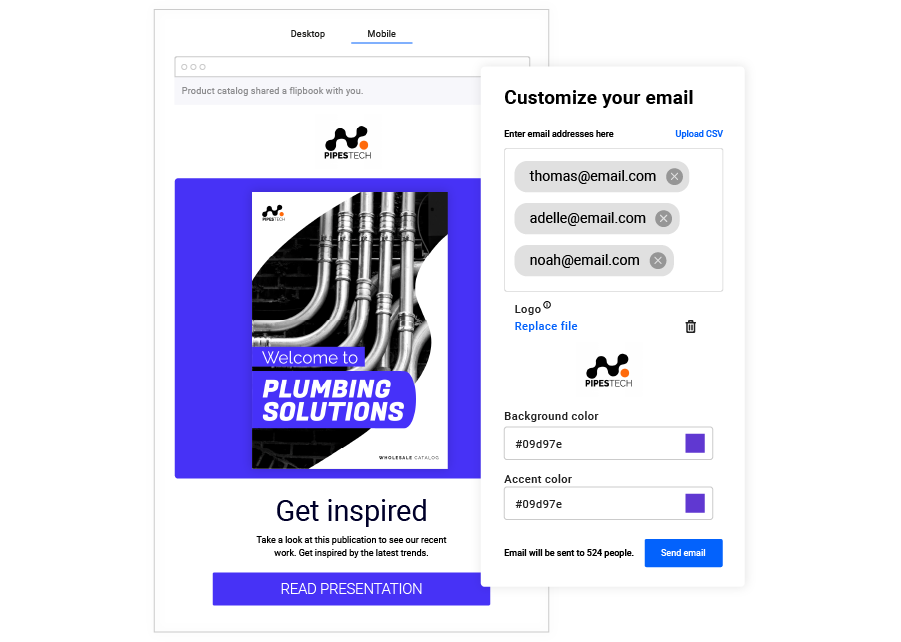
The use of email in marketing strategies isn’t something new. Before the digital wave, physical mail was used as a way to communicate and connect with customers, but with emails, this form of direct marketing took audience targeting to new levels. As a way to inform customers of new products or services, increase brand awareness, and promote discount campaigns, email marketing can be effective in engaging existing customers or attracting new ones through different email campaigns. An often overlooked aspect is how email marketing enhances internal communication for better team collaboration.
Personalized email campaigns
Segment your customer lists and send targeted emails with personalized content to increase engagement and conversion rates. Personalization can include using the recipient’s name, recommending products based on past purchases, and tailoring content to their interests. Create eye-catching subject lines to draw the reader’s attention and boost open rates with branded emails. You can boost your email newsletter engagement by sharing your digital catalog as a clickable cover preview that takes them to a full-view experience of your publication.
Internal distribution
Share digital catalogs with employees and sales representatives to ensure they have the latest information and can effectively promote your products. This internal sharing can also help gather feedback and improve the catalog before wider distribution. Effective internal communication ensures that everyone is working together towards the same goal and equipped to engage customers successfully. Regular internal newsletters can inform the team about new products, promotions, and company news, fostering a cohesive and informed workforce that can better serve customers. Sales teams can more effectively increase conversion rates if they always have access to the latest catalog.
Embedded catalog links
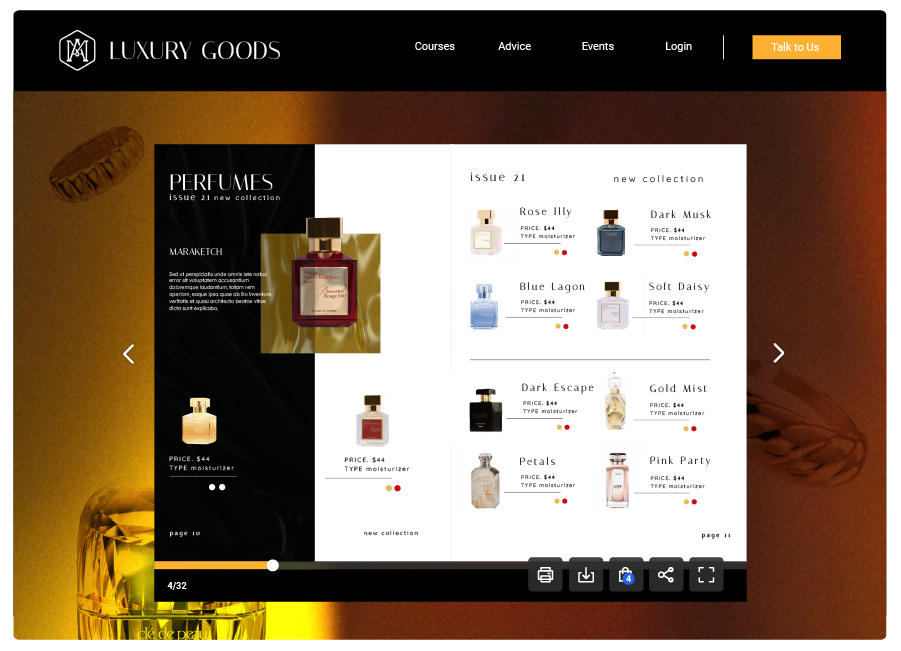
As the most interactive online catalog distribution option, embeds can be integrated into websites or other platforms for visitors to access directly. Overall, this distribution or promotion method increases website engagement by keeping your online visitors occupied longer.
Website integration
Embedding your digital catalog directly on your website makes it easily accessible to visitors, enhancing the user experience and keeping potential customers engaged longer. Ensure the catalog is prominently featured on relevant pages to maximize visibility. This not only helps in providing immediate access to the catalog but also integrates seamlessly with your overall web content, encouraging more interactions and conversions.
Blog and content marketing
Using embedded catalogs in blog posts is an effective strategy to drive traffic and engagement. This approach not only showcases your products but also improves SEO by keeping visitors on your site longer and reducing bounce rates. By embedding catalogs in high-traffic blog posts, you can capture the interest of readers who are already engaged with your content, providing them with a richer experience.
QR codes
While QR codes have existed for nearly 30 years, it was only during the pandemic that they became popular. Restaurants started to use them to limit the spread of the virus by replacing physical menus with QR codes that customers could scan to choose their order. They work as shortcuts to getting the customer exactly where you want them with as little hassle or hoops to jump through. Still, their benefits extend beyond simply giving a swift connection to the offer.
Trade shows and events
Utilizing QR codes at trade shows and events allows attendees to access your digital catalog easily. This is a great way to engage with potential customers and collect leads without having to send individual links to all potentials that stop by your booth. QR codes can be displayed on banners, flyers, and promotional materials, offering a convenient bridge between physical and digital marketing. Like that, your costs for trade shows will be less exhaustive without missing out on crowds of people who may be left without any physical copies of your catalog. QR codes don’t run out and aren’t limited to a specific number of people who can access their hidden links.
Print materials
As mentioned above, including QR codes in brochures and flyers effectively bridges the gap between offline and online marketing efforts. This provides a seamless customer experience by making it easy for customers to transition from physical to digital content with a simple scan. QR codes in print materials can significantly enhance the reach and accessibility of your digital catalog, giving your target audience a more interactive and engaging version of your catalog that can also be used to create shopping lists and send orders directly to your established email address.
Technical aspects of catalog distribution
When distributing digital catalogs, several technical aspects must be considered to maximize their effectiveness. These strategies collectively enhance your digital catalogs’ reach, engagement, and inclusivity.
Mobile optimization
To ensure your digital catalogs cater to the increasing number of mobile users, implement a responsive design that adjusts the layout and content to fit various screen sizes, providing a seamless experience. A smooth browsing experience across all devices is crucial for keeping users engaged and reducing bounce rates. Prioritize fast load times, easy navigation, and interactive elements to enhance the user journey on smartphones and tablets.
SEO best practices
Incorporating SEO best practices, such as using relevant keywords, meta descriptions, and alt text, can significantly boost your catalog’s visibility and drive organic traffic. Properly optimized digital catalogs rank higher in search results, making it easier for potential customers to find your products. Enhance your catalog’s SEO by optimizing keywords, crafting compelling meta descriptions and titles, adding alt text to images, and including internal links. Mobile optimization also plays a vital role in improving search engine rankings.
Accessibility compliance
Adhering to Web Content Accessibility Guidelines (WCAG) ensures your catalogs are accessible to users with disabilities, expanding your potential customer base. This includes providing alternatives for non-text content, ensuring keyboard navigability, and using accessible color contrasts. By making your digital catalogs accessible, you not only comply with legal requirements to be accessible but also create an inclusive experience that can attract a broader audience.
Flipsnack for online catalog distribution
Flipsnack offers diverse public sharing options to maximize the reach and engagement of your digital catalogs. These ensure that your digital flipbooks will reach your audience regardless of where or how they try to access your content online:

Additionally, private sharing options are available for secure communication with stakeholders or personalized offers that are limited to a company, for example. These ensure that your communication won’t get into the wrong hands and that any private negotiations with customers or other stakeholders are done sensitively.
Conclusion
In the competitive world of commerce, leveraging effective marketing strategies is crucial for driving business growth. Digital catalogs offer a cost-effective and versatile solution to reach a broader audience, engage customers, and streamline updates. By understanding your audience, setting clear goals, and utilizing various online sharing strategies, businesses can maximize the impact of their digital catalogs. Catalogs have been evolving along with different technologies, and now we can implement multiple features to streamline everything from production to distribution, and why noy, incoming orders from customers.

Flipsnack provides robust distribution tools, including shareable links, social media integration, email embedding, and QR codes, ensuring your digital catalogs reach and captivate your target audience efficiently. Any business that creates catalogs in PDF format for print or online distribution can convert them into interactive flipbooks and reap the benefits of a more engaged customer base. Embrace digital catalogs to enhance your marketing efforts and achieve greater success.
